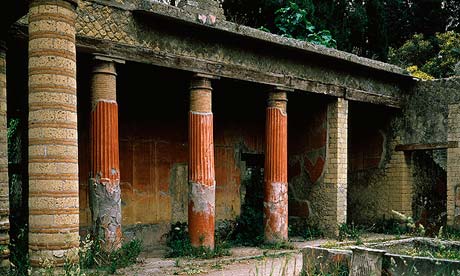Buried by Vesuvius nearly 2,000 years ago, archaeologists at Herculaneum
have excavated and carried out the first-ever full reconstruction of
the timber roof of a Roman villa
With several dozen rooms, the House of the Telephus Relief was 'top-level Roman real estate'. Photograph: Art Archive/Alamy
For almost two millennia, the piles of wood lay undisturbed and
largely intact under layers of hardened volcanic material. Now, after
three years of painstaking work, archaeologists at Herculaneum have not
only excavated and preserved the pieces, but worked out how they fitted
together, achieving the first-ever full reconstruction of the timberwork
of a Roman roof.
With several dozen rooms, the House of the
Telephus Relief was "top-level Roman real estate", said Andrew
Wallace-Hadrill, the director of the Herculaneum Conservation Project
(HCP). It was more of a palace or mansion, thought to have been built
for Marcus Nonius Balbus, the Roman governor of Crete and part of
modern-day Libya, whose ostentatious tomb was found nearby.
The
most lavishly decorated part of the immense residence was a three-storey
tower. On the top floor was a nine-metre high dining room with a
coloured marble floor and walls, a suspended ceiling and a wrap-around
terrace. It offered the owners and their dinner guests a heart-stopping
view across the silver-blue Bay of Naples to the islands of Ischia and
Capri.

No comments:
Post a Comment
Note: Only a member of this blog may post a comment.